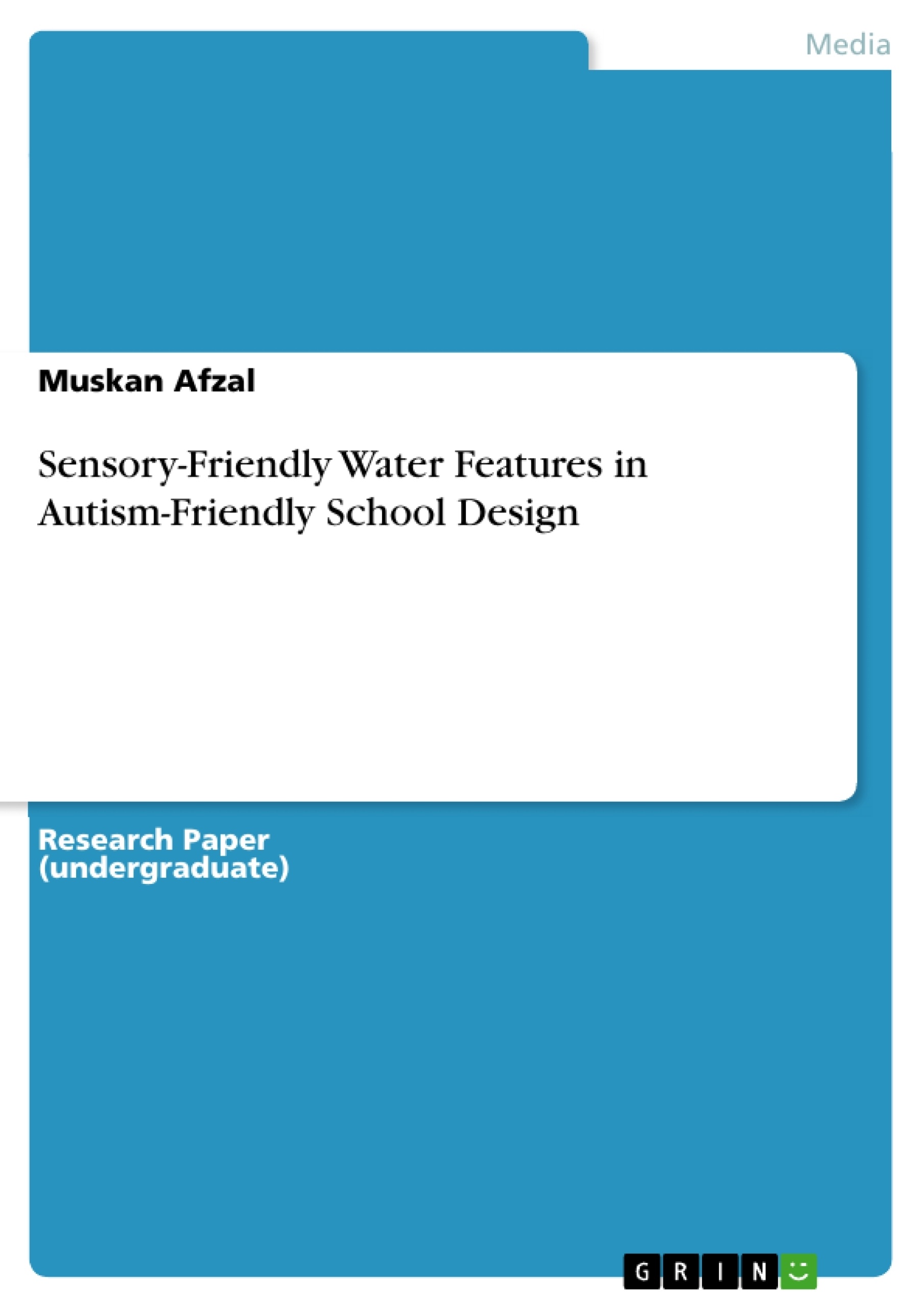As the prevalence of autism spectrum disorders continues to rise, there is a growing recognition of the importance of creating educational spaces that foster inclusivity and support the diverse learning styles of autistic students. Traditional school settings often struggle to provide the tailored support required for the diverse learning styles and sensitivities of autistic students. The varied sensory demands of people, especially those who are autistic, have been more widely acknowledged in educational settings in recent years. To improve the educational experience and general well-being of students with autism spectrum disorder (ASD), this study investigates the incorporation of sensory-friendly water features into the architecture of autism-friendly schools. Since water features are known to have therapeutic and relaxing effects, they may be advantageous for autistic students in educational environments. This study offers insights into the possible effects of sensory-friendly water elements on the learning environment for autistic students.
Inhaltsverzeichnis (Table of Contents)
- I. INTRODUCTION
- II. BENEFITS OF SENSORY-FRIENDLY WATER FEATURES
- A. Promoting Calm and Reducing Anxiety
- B. Sensory Stimulation and Exploration
- C. Therapeutic Advantages
- III.TYPES OF SENSORY-FRIENDLY WATER FEATURES
- A. Water Walls
- B. Reflecting Pools
- C. Bubbling Fountains
- D. Rain Gardens
- IV.DESIGN CONSIDERATIONS FOR AUTISM-FRIENDLY WATER FEATURES
- A. Safety
- B. Accessibility
- C. Maintenance
- D. Integration with the Environment
- V. THE POSITIVE EFFECTS OF INTEGRATING SENSORY-FRIENDLY WATER FEATURES IN AUTISM-FRIENDLY SCHOOL ENVIRONMENTS
- A. Sensory Control and Emotional Well-Being
- B. Inclusive and Supportive Learning Environments
- C. Fostering Inclusion and Acceptance
- VI. CONCLUSION
Zielsetzung und Themenschwerpunkte (Objectives and Key Themes)
This study aims to investigate the potential benefits of incorporating sensory-friendly water features into the architecture of autism-friendly schools. It explores the impact of these features on the learning environment for autistic students, considering their therapeutic, cognitive, and emotional advantages. The study also examines various types of sensory-friendly water features and their design implications.
- The therapeutic effects of sensory-friendly water features for autistic students
- The impact of water features on sensory stimulation and exploration in autism-friendly schools
- Design considerations for incorporating sensory-friendly water features in educational environments
- The positive effects of integrating sensory-friendly water features on inclusivity and acceptance within school communities
- The importance of sensory-friendly design in promoting emotional well-being and sensory regulation for individuals with autism
Zusammenfassung der Kapitel (Chapter Summaries)
I. INTRODUCTION: This chapter provides an overview of Autism Spectrum Disorder (ASD) and its impact on social interaction, communication, and behavior. It highlights the importance of creating inclusive educational spaces that cater to the unique needs of autistic students, emphasizing the potential benefits of sensory-friendly water features.
II. BENEFITS OF SENSORY-FRIENDLY WATER FEATURES: This chapter discusses the therapeutic, cognitive, and emotional advantages of sensory-friendly water features in learning environments. It emphasizes their ability to promote calm, reduce anxiety, and provide opportunities for sensory stimulation and exploration. The chapter also explores the therapeutic potential of water play for autistic children.
III.TYPES OF SENSORY-FRIENDLY WATER FEATURES: This chapter explores various types of sensory-friendly water features that can be incorporated into autism-friendly school designs. It includes detailed descriptions of water walls, reflecting pools, bubbling fountains, and rain gardens, highlighting their unique sensory characteristics and potential benefits for autistic students.
IV.DESIGN CONSIDERATIONS FOR AUTISM-FRIENDLY WATER FEATURES: This chapter focuses on key design considerations for creating sensory-friendly water features in educational environments. It addresses crucial aspects such as safety, accessibility, maintenance, and integration with the surrounding environment, ensuring that water features are safe, inclusive, and effectively integrated into the overall school design.
V. THE POSITIVE EFFECTS OF INTEGRATING SENSORY-FRIENDLY WATER FEATURES IN AUTISM-FRIENDLY SCHOOL ENVIRONMENTS: This chapter explores the positive effects of integrating sensory-friendly water features in autism-friendly school environments. It examines how these features can enhance sensory control, promote emotional well-being, and foster inclusive and supportive learning environments for autistic students. The chapter highlights the importance of sensory-mitigated design and its role in improving the overall learning experience for individuals with autism.
Schlüsselwörter (Keywords)
This study focuses on the design of inclusive and sensory-friendly learning environments for autistic students, particularly exploring the therapeutic and educational benefits of incorporating water features into school architecture. Key terms and concepts include Autism Spectrum Disorder (ASD), sensory-friendly design, water features, relaxation, sensory stimulation, inclusivity, and accessibility. The study examines the potential impact of sensory-friendly water elements on emotional well-being, sensory regulation, and the overall learning experience of autistic individuals.
- Quote paper
- Muskan Afzal (Author), 2024, Sensory-Friendly Water Features in Autism-Friendly School Design, Munich, GRIN Verlag, https://www.grin.com/document/1494722



